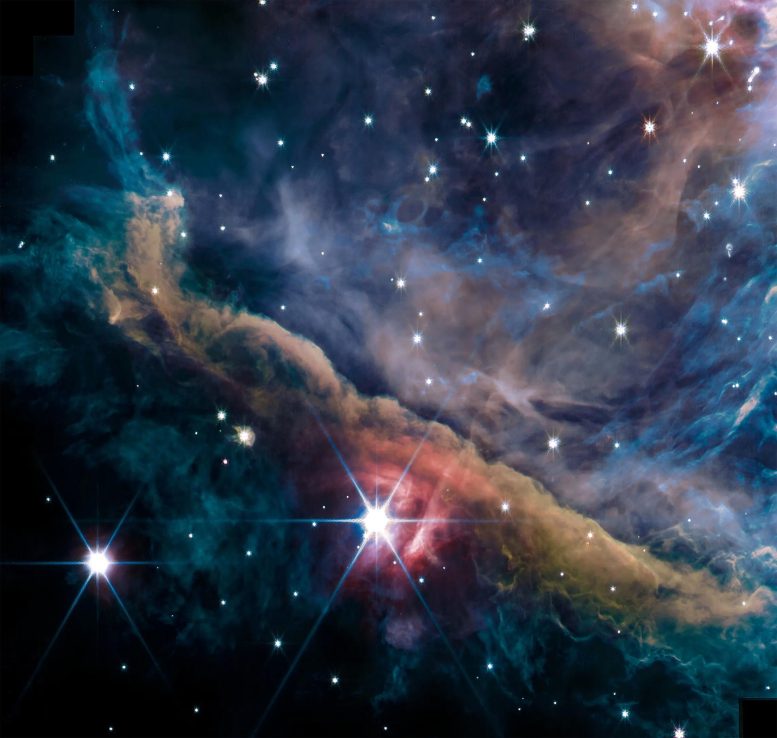
The inner region of the Orion Nebula as seen by the James Webb Space Telescope’s NIRCam instrument. Credit: NASA, ESA, CSA, Data reduction and analysis: PDRs4All ERS Team; graphical processing S. Fuenmayor
James Webb Space Telescope’s first images of the Orion Nebula, the richest and closest star nursery to our solar system, have just been revealed by an international team of astronomers including University of Michigan (U-M) researchers.
Located in the constellation of Orion, roughly 1,350 light-years away from Earth, the Orion Nebula is an area rich in matter where many stars are formed. Its environment is thought to be similar to the environment in which our solar system was born more than 4.5 billion years ago. Therefore, studying the Orion Nebula allows scientists to understand the conditions in which our solar system formed.
“Orion Bar is a prototype region for processes that occur throughout our galaxy and the universe as stars continually irradiate nearby material,” said Felipe Alarcon. He is a U-M graduate student and member of the international group. “This amazing picture will be a template image.”
Large amounts of dust obscure the heart of star nurseries, such as the Orion Nebula. This makes them impossible to observe in visible light with telescopes such as the Hubble Space Telescope. However, the James Webb Space Telescope observes the infrared light of the cosmos, which can penetrate these layers of dust.
Many spectacular structures are revealed in the image, down to scales of about 40 astronomical units, or about the size of our solar system. These structures include a number of dense filaments of matter, which could launch the birth of a new generation of stars. Forming stellar systems are also revealed in the image. These consist of a central proto-star surrounded by a disc of dust and gas inside which planets form.
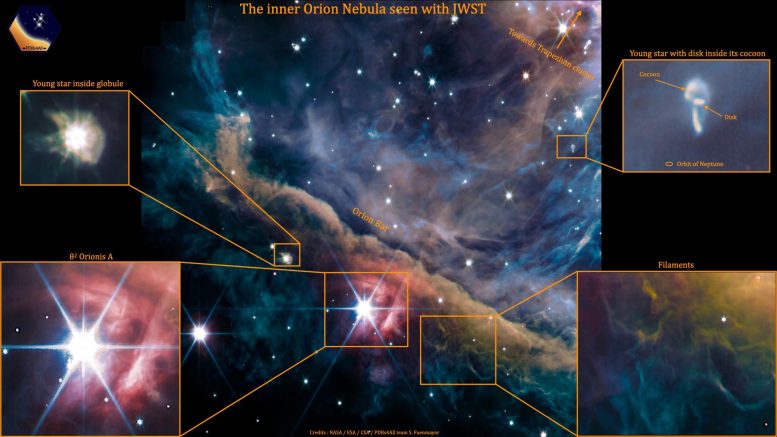
Young star with a disk inside its cocoon: Planet forming disks of gas and dust around a young star. These disks are being dissipated or “photo-evaporated” due to the strong radiation field of the nearby stars of the Trapezium creating a cocoon of dust and gas around them. Almost 180 of these externally illuminated photoevaporating disks around young stars (aka Proplyds) have been discovered in the Orion nebula, and HST-10 (the one in the picture) is one of the largest known. The orbit of Neptune is shown for comparison.
Filaments: The entire image is rich in filaments of different sizes and shapes. The inset here shows thin, meandering filaments that are especially rich in hydrocarbon molecules and molecular hydrogen.
θ2 Orionis A: The brightest star in this image is θ2 Orionis A, a star that is just bright enough to be seen with the naked eye from a dark location on Earth. Stellar light that is reflecting off dust grains causes the red glow in its immediate surroundings.
Young star inside globule: When dense clouds of gas and dust become gravitationally unstable, they collapse into stellar embryos that gradually grow more massive until they can start nuclear fusion in their core – they start to shine. This young star is still embedded in its natal cloud.
Credit: NASA, ESA, CSA, Data reduction and analysis: PDRs4All ERS Team; graphical processing S. Fuenmayor & O. Berné
“We hope to gain understanding about the entire cycle of star birth,” said Edwin (Ted) Bergin. He is a U-M professor and chair of astronomy and member of the international research team. “In this image, we are looking at this cycle where the first generation of stars is essentially irradiating the material for the next generation. The incredible structures we observe will detail how the feedback cycle of stellar birth occurs in our galaxy and beyond.”
The Orion Nebula is also home to a cluster of massive young stars, called the Trapezium Cluster, emitting intense ultraviolet radiation, capable of shaping clouds of dust and gas. Understanding how this phenomenon influences the environment is a key question for studying the formation of star systems like our own solar system.
These images are the result of one of James Webb Space Telescope’s priority observation programs, involving about a hundred scientists in 18 countries.
The JWST is a large infrared telescope with an approximately 6.5-meter primary mirror. With its incredible power, it will be the premier observatory of the next decade and study every phase in the history of the universe. JWST is an international collaboration between NASA, ESA (European Space Agency), and the Canadian Space Agency (CSA).
[Editor’s Note: An earlier version mistakenly called the Orion Nebula the closest star nursery “in” our solar system. This should have been closest star nursery “to” our solar system.]

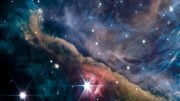
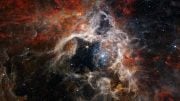
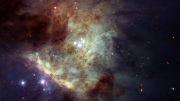
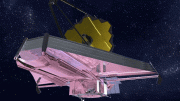



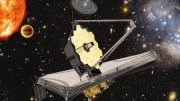
Strange that you call it the births of stars. Isn’t it more correct: the births of the planets around newborn stars!
Topological vortexes underlie the formation and interactions of matter in space-time, and is the driving force behind the endless motion of space-time.
If there is no physical environment with dark matter and dark energy topological vortexes, there can be neither all kinds of celestial bodies and microscopic particles nor the interaction of them.
The title of the article is shockingly inaccurate. There are no “star nurseries” in the solar system, but rather in the galaxy, many light-years away and beyond our solar system.
Thank you for the comment. It should have said closest “to” the solar system instead of “in” the solar system.
The article has been corrected.
Wow, didn’t know the ‘solar vsystem’ extended so far. 🙂
Thank you for the comment. It should have said closest “to” the solar system instead of “in” the solar system.
The article has been corrected.
“the richest and closest star nursery in the solar system”
lolwut
Thank you for the comment. It should have said closest “to” the solar system instead of “in” the solar system.
The article has been corrected.
Wow! We definitely don’t have a star nursery in our solar system. Maybe University of Michigan needs to go back to school?
Thank you for the feedback. It should have said closest “to” the solar system instead of “in” the solar system.
The article has been corrected.
Please proofread title. Should be galaxy, not solar system.
Thank you for the feedback. It should have said closest “to” the solar system instead of “in” the solar system.
The article has been corrected.
Please make correction; Stars are not forming in our solar system, but in our galaxy or beyond.
Thank you for the comment. It should have said closest “to” the solar system instead of “in” the solar system.
The article has been corrected.
There are NO “star nurseries” in the solar system. Kindly correct the article accordingly.
Thank you for the feedback. It should have said closest “to” the solar system instead of “in” the solar system.
The article has been corrected.
All I can see is a skull riding a dragon
“In our solar system..”
Not even close!
Thank you for the comment. It should have said closest “to” the solar system instead of “in” the solar system.
The article has been corrected.
Wow how can something like that be published by a professional science writer? Luckily you will be replaced by a more scientifically literate AI soon.
Thank you for the comment. It should have said closest “to” the solar system instead of “in” the solar system.
The article has been corrected.